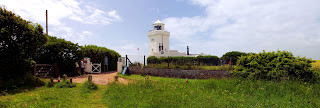
I had driven down the previous evening to the Hawthorn Farm campsite at Martin Mill on the outskirts of Dover in Kent where I had arranged to meet my younger Bro, Sis in Law and the rinky dinks. The rinky's were asleep when I finally rolled up in semi darkness, following a rather long and occasionally tedious five and a half hour trip from the North West. The tent was quickly pitched, illuminated by car headlights and after a meal and a catch up we all retired to our respective tents.
The campsite was lovely and very peaceful, apart from the gunfire obviously ! The camping fields were flat, lush and luckily not too busy. The facilities were well maintained and were within easy reach from our location. There was an extremely large population of rabbits and these were clearly very used to living alongside people as they came very close to the various tents to claim the lushest of grass. This with hindsight, was probably an error on their part, given the gunshots we were to hear the following morning, however maybe not suprising given that rabbits are generally thicker than a Japanese' tourists photo album !


Following our rude awakening the following morning, we rose, lit a fire, prepared breakfast, showered and eventually headed off to the hugely impressive Dover Castle and the infamous secret underground wartime tunnels.
One of the largest castles in the country, and surely one of the best preserved, it is strategically located at the shortest crossing point to the continent. Dover Castle has played a prominent part in our nations history which can be traced back to the Iron Age. A Roman Lighthouse and an Anglo-Saxon church can still be seen within the castle walls and both are visible in the lower of the 2 photo's below. 

William (The Conqueror) of Normandy strengthened existing Anglo-Saxon fortifications in 1066, but it was Henry II who really developed the castle when he had the fortifications rebuilt in the 1180's. This development added a huge keep & a series of concentric defences. As the centuries passed, the defences were continually enlarged and improved. The castle maintained a military role until well into the mid twentieth century. Beneath the castle are a series of huge underground tunnels which were kept secret until fairly recently. These tunnels were used extensively by the Armed Forces during the Second World War and under the Command of Admiral Ramsay, became the command post for the planning of the Dunkirk evacuation.
The tunnels were excellent and were far larger than I had imagined. We were guided through the various rooms which included a military hospital, telephone exchange, and numerous other areas which were used by all of the Services as part of the war effort.
The following day we decided to visit the Impressive Victorian, South Foreland Lighthouse on the Cliffs between Dover and St Margarets. It was built in the 1840's to warn ships approaching the nearby Goodwin Sands and was finally taken out of service in 1988 whereupon it was bought by the National Trust. South Foreland has the distinction of being the first lighthouse in the World to use an electric light. The lighthouse was also used by Guglielmo Marconi during his work on radio waves.
Originally there was another lighthouse further down towards the cliff which was built to be used in conjunction with South Foreland in order to give a bearing as to a safe route to take across the sands. However, the Sands shifted over the following years until this bearing became dangerously inaccurate and so the lower light was taken out of service in 1910.
The sands themselves are infamous and the water is so shallow across them that, each year at low tide, a game of cricket takes place on the sands themselves. As you would expect the sands have claimed a huge number of shipwrecks over the years and each one had been meticulously mapped. The numbers of ships lost was truly astonishing.
I'd never visited a lighthouse before although I had always fancied living and working in one. As people who know me will confirm, I'm more than happy in my own company so the thought of spending 6 months a year in a circular house with nothing but myself to keep me company doesn't phase me at all. Unfortunately for me, Trinity House automated all of it's lighthouses during the 80's & 90's and the final manned lighthouse, coincidentally a stone's throw up the coast at North Foreland, closed its doors in 1998.

 Once again the wind was blowing quite hard but then again, we were standing on the Dover White Cliffs 300 feet above the English Channel. The lighthouse was wonderful, a breathtaking pure white stone in colour, a Union flag waving enthusiastically on its flagpole alongside. The lighthouse itself was quite small on the inside and had that distinctive smell of warm oil as you entered through the low door. The lighthouse was full of visitors and the logistics of getting everybody up and down the tight, spiral staircases without meeting people coming in the opposite direction, seemed quite a feat. Our guide recounted the lighthouses history and showed us the weight mechanism that turned the optical lens cage upstairs. The light itself - a considerably larger version of the light bulbs you have in your houses - doesn't move, as it is the lens that surrounds it that spins, flashing 3 lights every 20 seconds. In the maritime World, every lighthouse within 100 nautical miles has a unique identifier. So you may have a single flash on one lighthouse and a 3 flash light on another and maybe a 2 short flash and 2 long flash on a third.
Once again the wind was blowing quite hard but then again, we were standing on the Dover White Cliffs 300 feet above the English Channel. The lighthouse was wonderful, a breathtaking pure white stone in colour, a Union flag waving enthusiastically on its flagpole alongside. The lighthouse itself was quite small on the inside and had that distinctive smell of warm oil as you entered through the low door. The lighthouse was full of visitors and the logistics of getting everybody up and down the tight, spiral staircases without meeting people coming in the opposite direction, seemed quite a feat. Our guide recounted the lighthouses history and showed us the weight mechanism that turned the optical lens cage upstairs. The light itself - a considerably larger version of the light bulbs you have in your houses - doesn't move, as it is the lens that surrounds it that spins, flashing 3 lights every 20 seconds. In the maritime World, every lighthouse within 100 nautical miles has a unique identifier. So you may have a single flash on one lighthouse and a 3 flash light on another and maybe a 2 short flash and 2 long flash on a third. 
We finally came down and headed back to the car along the path, stopping off for tea & scones at a fantastic tea shop as we approached St Margarets. As we left the property, wiping crumbs from our faces, we bid each other our farewells and headed home. Great weekend.... well maybe not if you're a rabbit !
The previous weekend, I had visited the Royal Navy's flagship, the Invincible Class Aircraft Carrier, Ark Royal. The Ark was in Liverpool for the weekend where it was taking part in some official duties but was also open for public viewing. I decided to go and take a look as Ark Royal has always been my favourite ship. The ship was berthed at the brand new Cruise Ship facility at The Pier Head and was hugely popular as she had not visited the city previously in her 23 year history.  Unfortunately this trip coincided with the Liverpool Lord Mayors Parade and this meant that the traffic was horrendous and also that the ships visitor numbers were probably dramatically inflated. This may well have been a bonus for the Navy but it did mean that thousands of us were unable to board as the queue was closed for new joiners several hours earlier than planned. I queued for 2 1/2 hours and was still turned away ! The ship was impressive, although I had seen her several times before in Portsmouth. I did notice however that she was showing signs of rust, most of which had been cosmetically painted to hide the brown staining.
Unfortunately this trip coincided with the Liverpool Lord Mayors Parade and this meant that the traffic was horrendous and also that the ships visitor numbers were probably dramatically inflated. This may well have been a bonus for the Navy but it did mean that thousands of us were unable to board as the queue was closed for new joiners several hours earlier than planned. I queued for 2 1/2 hours and was still turned away ! The ship was impressive, although I had seen her several times before in Portsmouth. I did notice however that she was showing signs of rust, most of which had been cosmetically painted to hide the brown staining.  On my way back to the car park, I was gutted to discover that my camera battery had died. This was because, as I walked along the water front, I spotted a car sailing past me on the Mersey ! Not a sight I had ever witnessed before. Clearly this was some sort of amphibious car, complete with wheels and number plates being driven down the river by a ruddy faced man with an especially fat neck ! I wish I had a photo for you but alas I'll have to leave it to your imagine.
On my way back to the car park, I was gutted to discover that my camera battery had died. This was because, as I walked along the water front, I spotted a car sailing past me on the Mersey ! Not a sight I had ever witnessed before. Clearly this was some sort of amphibious car, complete with wheels and number plates being driven down the river by a ruddy faced man with an especially fat neck ! I wish I had a photo for you but alas I'll have to leave it to your imagine.
So we started with gunfire, we ended with warships and had fortified castles and 2nd World War operations in the middle, making this one of my more violent blogs. Next time I post It'll be a little more gentile as I'm off to the formerly Nazi occupied Island of Jersey ! So nothing very violent to report there !
Things that made me smile this week:-
My Colleague Dave, passed wind and then explained "It's better to have an empty house than a rogue tenant "
And on that note ......
Wednesday, 2 July 2008
Camping, Rabbits and Warships
Daubed on the walls by
John
at
20:49
![]()
Subscribe to:
Post Comments (Atom)

No comments:
Post a Comment